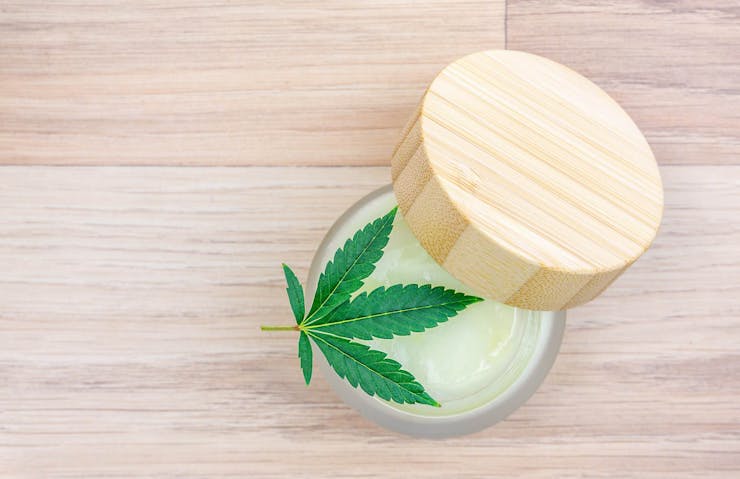Part of our fascination with cannabis comes from its versatility—you can smoke it, you can eat it, and you can stick it where the sun doesn’t shine. There are thousands of cannabis products in any given market, and celebrity cannabis brands and collaborations seem as commonplace as a fast food endorsement.
One of the most enduring cannabis creations is probably considered the least exciting or cool method of consumption: topicals. And no wonder—they’re typically marketed as anti-aging creams, recovery tools for athletes, or a solution for menstrual cramps.
Topicals admittedly don’t sell as easily as the next zaza strain, vape pens, or hash gummies, but the thing is, everyone can benefit from topicals. You can even make them at home. Consider this our definitive guide on topicals.
What is a cannabis topical?
Topical is an umbrella term for a wide array of cannabis-infused products that are formulated and designed for application to the skin. Unlike smoking, vaping, dabbing, or eating edibles, topicals should not be inhaled or ingested. On the rare occasion when someone does, they don’t work the way a product made for ingestion does.
The most common topical you’ll see in a dispensary is some iteration of a cannabis-infused cream or balm, which may also offer skin care benefits. In recent years, cannabis entrepreneurs have introduced cannabis body oils, sexual lubricants, bath salts, bath bombs, sprays, and transdermal patches to the mix. There’s something for all needs and tactile experiences.
Most topicals feature THC, CBD, or some combination of the two, and each cannabinoid offers unique healing properties when delivered topically. Newer formulas and wellness brands may use other, more niche cannabinoids in their formulas, like CBN, THCV, CBDA, and THCA.
What are the different kinds of topicals?
We are living in a topical renaissance, with more options for formulation and product type than ever before. Your local dispensary will likely carry at least one:
- Salve
- Cream
- Oil
- Lotion
- Spray
- Bath product (salts, bath bombs)
- Transdermal patch
More emollient topicals like a balm or cream are great carriers for cannabis-infused oils, as they incorporate oils well and spread on the skin easily. For those with oily skin, a spray-based formula may work better; sprays often also contain alcohol as a solvent to help cannabinoids penetrate better.
Shop highly rated dispensaries near you
Showing you dispensaries nearBath products, such as bath bombs or salts, offer a nice self-care experience alongside the plant medicine. They also allow for a full-body experience rather than just treating a localized issue like a sore knee or wrist. Keep in mind that these are often single-use products and a consistent regimen will cost more than a jar of cream or bottle of lotion.
How do topicals work?
What sets most topicals apart from other cannabis products is that they do not enter the bloodstream. Cannabis intoxicates us when we smoke, vape, or eat an edible, and activated cannabinoids enter our bloodstream.
Cannabinoids then interact with our endocannabinoid system, a complex network of receptors throughout our body that helps regulate systems like digestion and immunity. Of these receptors, CB1 receptors, which mostly manifest in the brain and nervous system, particularly interact with THC, hence the intoxication and euphoria we feel when consuming it. CB2 receptors can be found throughout the body’s organs and immune system. Both of these receptors are also found in the skin, though they interact with cannabinoids differently.
Our top skin layers, the epidermis and dermis, protect our bodies from chemicals and debris, and make it challenging to absorb cannabinoids.
But while you won’t get high from most commercial topicals, they do still reach local cannabinoid receptors in the skin. What topicals can offer that other products don’t is a targeted, site-specific relief from inflammation, nerve pain, arthritis, muscle cramps, and even migraines.
Do topicals get you high?
For the most part, no. One of the biggest selling points of topicals is that they won’t get you high and won’t show up on drug tests. And that’s largely true—most topical formulas absorb into the dermis and only interact with the local receptors there, so they won’ breach the blood barrier to intoxicate the user nor permeate the body enough to show up on a drug test.
But there are some exceptions, for example, weed lube. The market for cannabis lubricants and sexual wellness products meant to help with arousal and stimulation has grown a lot in the last couple years. Some are water-based, others oil-based, so choosing the best one for you is a personal endeavor. Some may contain penetration enhancers that can penetrate the bloodstream, and many permeable membranes are found in and around the genitals.
Transdermal topicals, such as gels or patches, are applied to a veiny area of the body, like the inner wrist or the top of a foot, and administer a steady, low, dose of cannabinoids over a period of hours.
Due to penetration enhancers in formulas, cannabis in transdermal patches may enter the bloodstream and impart a high, according to a study on rats. So if a transdermal topical has THC in it there is a chance of intoxication, and you risk a positive drug test when using one.
How are topicals used?
Topicals are one of the easiest cannabis products to use—simply slather wherever you see fit! Many people apply them to localized areas for pain or inflammation relief. In addition to cannabinoids, many formulas contain cooling, moisturizing, and soothing ingredients like menthol, hyaluronic acid, and essential oils.
Topicals work best on clean skin. Anecdotally, using topicals after a shower or bath may increase efficacy due to the skin’s moisture and open pores, but this is not proven scientifically. For transdermal patches, skin should be dry for optimal adhesion.
Just as different strains impart different effects, the cannabinoid profile in a topical will offer relief for different symptoms. Preliminary research has shown that applying cannabis to the skin, particularly CBD, not only helps with pain, muscle soreness, and inflammation, but can also relieve topical skin conditions like eczema and acne.
How to make topicals at home
Yes, you absolutely can make cannabis topicals at home. But it’s hard to reproduce a commercially-made product with correct dosing at home, so we advise that you speak with a healthcare professional or budtender about making your own.
Here are three different methods for creating cannabis topicals.
Cannabis topical oil recipe
This method is pretty simple. Essentially, you’re infusing cannabis to a carrier oil like coconut oil, which you can then apply directly to the skin, or mix into other products. This method calls for decarboxylated cannabis, but you can also use raw cannabis or a mix of the two, to pack in even more benefits from the plant.
Equipment
- Medium cooking pot
- Metal or pyrex mixing bowl that fits on top of the pot
- Probe thermometer
- Cheesecloth or strainer
- Storage jar or bottle
Ingredients
- Half-ounce to a full ounce of dried (14-28 grams) ground cannabis
- 8-16 fl. oz. oil (coconut, olive)
Directions
Decarb your cannabis (optional). This depends on how you want to formulate your topical, but isn’t necessary. To decarb weed, check out our guide. Essentially, bake the weed on a tray in the oven for around 30 minutes at 220º F before use.
Prep for the oil. Pour 2 cups of water into the cooking pot, set the stove to medium heat, and place bowl on top.
Heat the oil. Pour the amount of oil you desire to make. You want to make sure you have enough to fully coat the cannabis. Keep the oil at 150ºF, and no higher than 180ºF, to ensure activated cannabinoids aren’t burned off.
Let simmer. Let the mixture simmer for one to two hours, stirring occasionally.
Strain. Pour the oil mixture through the cheesecloth into your storage container and let cool before using. Store in a cool, dark place, out of direct sunlight. Voila!
Cannabis topical balm recipe
The balm method builds off of the oil recipe, making a richer balm to suit your sensory needs.
Equipment
- Medium cooking pot
- Metal or pyrex mixing bowl that fits on top of the pot
- Storage jar or bottle
- Probe thermometer
Ingredients
- Prepared cannabis oil (around 12 fl. oz.; see recipe above)
- Approx ⅓ cup beeswax pastilles (depending on your preferred texture)
- ⅓ cup additional oil, for texture
- Essential oils for aroma (optional)
Prep. Using the double boiler method again, pour 2 cups of water into the cooking pot, set the stove to medium heat, and place bowl on top. Pour cannabis oil into bowl.
Add beeswax and oils. Keeping a low temperature, incorporate the beeswax, essential oils and any other oils for desired texture and aroma. Stir gently until the consistency is uniform.
Store. Pour into storage container and let solidify before using.
Quick and easy cannabis topical recipe
If you’re pressed for time and don’t have the resources, you can always MacGyver a topical using a cannabis tincture and a lotion or cream you already have.
Simply add half a dropper’s worth of the tincture to a small amount of cream—do not mix it into the container!—and mix with your hands before applying to the body area in need.





